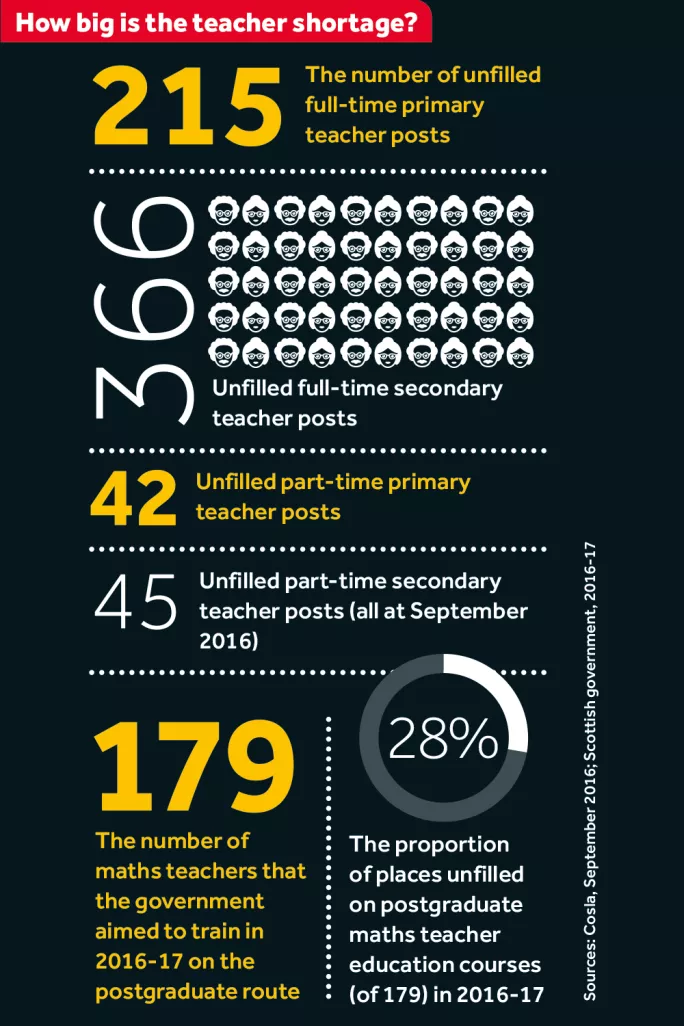
Primary, secondary - the new breed will teach both

Scotland’s teaching watchdog is launching a radical plan to create a new breed of teacher who is qualified to work in both primary and secondary schools, in a bid to tackle staff shortages.
Unions are warning that the change could “weaken the standard” of teaching, in secondary schools in particular, because the new teachers will not need a degree in the subjects they teach. Parents have also raised concerns about the move.
But the General Teaching Council for Scotland (GTCS) said allowing teachers to work across the broad general education (BGE) phase - which runs from nursery to S3 - would help to tackle the teacher recruitment crisis because councils will be able to deploy teachers more flexibly.
The organisation also claimed it could lead to a more seamless transition from primary to secondary for pupils.
The GTCS told Tes Scotland that the new type of registration, known as the Broad General Registration Category, was expected to be up and running during this school year.
Ahead of the official launch, some universities have decided to offer new teaching qualifications covering both the primary and secondary phases. On Monday, student teachers started a new two-year master’s in teacher education at the University of Edinburgh, which will qualify them to teach either as generalist teachers from nursery to S3 or as subject specialists in P5 to S6.
‘Freeing up time’
Meanwhile, at the University of Glasgow, students with a Higher in maths who have just started on the postgraduate route into primary teaching will be offered the chance to become maths specialists. When they complete their course, these teachers will be qualified to lead maths classes up to S3, Moyra Boland, deputy head of the university’s school of education, told Tes Scotland. This year, 15 places will be available on the new route. Ms Boland said: “This could free up time for secondary maths specialists to concentrate on certificated maths courses. We know there is a shortage of maths teachers and this is a creative way of looking at how we support that.”
However, Scottish Secondary Teachers’ Association general secretary Seamus Searson said: “This is not the solution to the teacher shortage. A Higher is not enough to deliver a subject in secondary. This is weakening the standard and it’s not fair to these people who will become second-class people in the [secondary] school.”
While the intention was that the new BGE teachers would not deliver national qualifications and would only take classes up to S3, the reality could be different, he added. “We already have history teachers being asked to deliver qualifications in subjects like RE where there is a shortage,” said Mr Searson.
The new category of registration has been approved by the GTCS council, and detailed proposals will now be developed and approved prior to the scheme opening to applicants. Larry Flanagan, general secretary of the EIS teaching union, said the move “raised questions” and could create a “two-tier system in the secondary sector” because some teachers would have degrees in the subjects they were delivering, while others would not.
The change could diminish the “status of the [new] teachers working in secondary schools”, he believed. Mr Flanagan added that the EIS was keen to uncover whether qualification to work in both sectors might lead to “a more fragmented experience” in the probationary year. He continued: “The EIS would wish to see these questions, and others, being fully addressed by the GTCS before following through on this plan.”
Joanna Murphy, chair of the National Parent Forum of Scotland, said innovation was welcome in tackling the teacher shortage, but the move risked “a brain drain” of teachers out of the primary sector due to shortages in secondary. She added: “Also, the current model in primary is one teacher for one class, and teachers coming in and out is not the norm. There might be a case for a secondary-style model in upper primary, but these things would have to be thought through.”
GTCS chief executive Ken Muir told Tes Scotland that the move was “in part a response to Curriculum for Excellence and in part to get more flexibility into the system”. He said: “This would give local authorities the flexibility to have teachers working across schools. It means if you have a shortage in some subjects - maths, English - S1, S2 and S3 could be taught by someone from the primary school.”
A GTCS spokeswoman added that the change would “facilitate effective working, and quality learning and teaching across the primary and secondary sectors”. It also had “huge potential in facilitating transitions between primary and secondary”.

You need a Tes subscription to read this article
Subscribe now to read this article and get other subscriber-only content:
- Unlimited access to all Tes magazine content
- Exclusive subscriber-only stories
- Award-winning email newsletters
- Unlimited access to all Tes magazine content
- Exclusive subscriber-only stories
- Award-winning email newsletters
You need a subscription to read this article
Subscribe now to read this article and get other subscriber-only content, including:
- Unlimited access to all Tes magazine content
- Exclusive subscriber-only stories
- Award-winning email newsletters
- Unlimited access to all Tes magazine content
- Exclusive subscriber-only stories
- Award-winning email newsletters